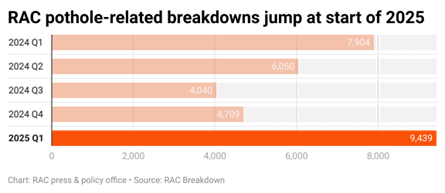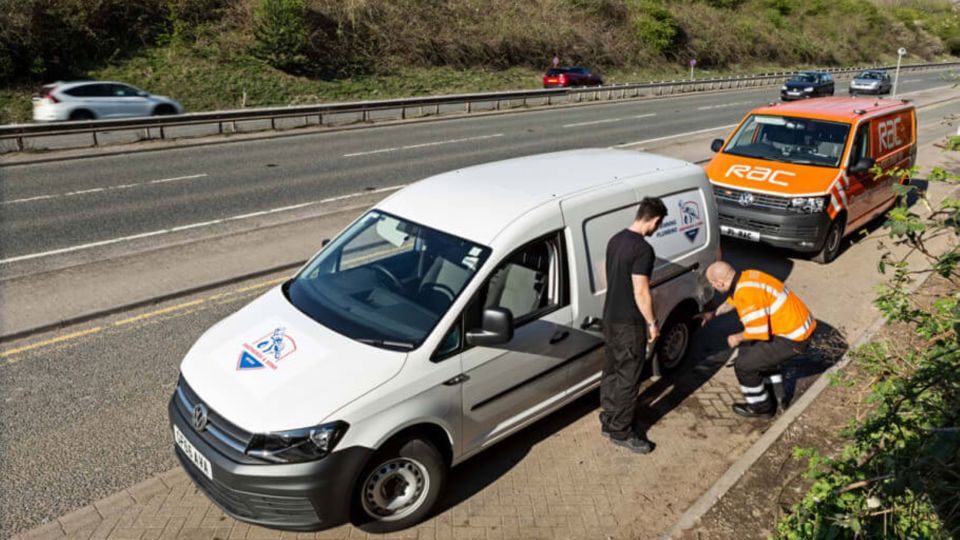The RAC attended double the amount of pothole breakdowns in the first three months of 2025, compared to the previous quarter, new analysis shows.
The breakdown and recovery company attended 9,439 breakdowns due to poor-quality roads in first quarter
Call-outs for damaged shock absorbers, broken suspension springs or distorted wheels – the breakdowns most likely to be caused by wear and tear from poor road surfaces – also increased by 19% (1,535 RAC rescues) when compared to the same period (January to March) in 2024.
The number of pothole breakdowns in the first quarter of 2025 equates to 1.5% of all RAC breakdowns – an increase on the fourth quarter of 2024 (0.8%) and the first three months of 2024 (1.1%).

RAC data also shows that drivers whose cars have suffered damage as a result of poor roads will have to pay an average of £460 for anything more serious than a puncture.
RAC head of policy Simon Williams said: “Our patrols have been to the aid of almost 10,000 members in the first three months of this year who have broken down due to effects of driving on substandard roads – a huge rise compared to the same period a year ago.
“While we know the Government has just given a record amount of funding to English councils to sort out their roads, the latest Department for Transport (DfT) data shows there’s plenty this money needs to be spent on, as a fifth of councils have more than 10% of their minor road networks in 'red' or 'poor' condition.”
Government data analysed by the RAC reveals many of England’s roads are in a dire state with a fifth (19%) of councils having more than 10% of their minor roads in 'red' or 'poor' condition, meaning further investigation is required to ascertain if immediate work is needed.
Road Haulage Association (RHA) policy lead, James Barwise, said: “With poorly maintained roads causing misery daily for road users, creating delays, diversions and adding to already high costs for businesses, we need to see urgent action to find solutions.
“That means local authorities equipped with the latest technology and training for longer lasting and more cost-effective road maintenance.
“We urge DfT to work with local decision-makers to fast-track this process.”
Best and worst performing local authorities
The authority with most of its B and C roads in red condition is Derbyshire with 38%.
The London boroughs of Merton and Havering have 34% and 26% respectively, with Nottingham in fourth spot with 21%.
Derbyshire was also top for having the most major roads in ‘red’ condition with 28%. Nottingham has the second most (19%), closely followed by Brighton and Hove (18%).
Barwise said: “These numbers further highlight the often short-term and temporary nature of repairs happening across the country.
“Earlier this year, we called on local authorities to allocate and ring-fence pothole funding for long-term and permanent fixes. Today we repeat our call.
“We welcome recent assurances from the Government, but it's obvious that much more needs to be done, faster to deliver a road network fit for a modern economy, and one which drivers deserve.”
In terms of minor roads classed as being ‘green’, which means no further investigation or work is needed to bring them up to standard, eight-in-10 (80%) councils have more than half of their B and C networks in this condition.
Conversely, a fifth (20%) have more than half their minor roads in need of further inspection or maintenance. For major roads, 88% of authorities have more than half in green condition.
Five authorities have 85% or more of their minor roads in green condition. These are the London borough of Bexley (96%), Sunderland (87%), Middlesbrough (86%), Newcastle upon Tyne (86%) and Walsall (85%).
For major roads classed as ‘green’, Sunderland is joint top with Bedford on 89%, followed by Gateshead, Middlesbrough and Sheffield, all on 88%.
Williams said: “Our pothole-related breakdown data is a very clear reflection of the true state of the UK’s roads, and it sadly shows the pothole plague is as prevalent as ever.
“Suffering a breakdown due to wear and tear caused by the poor quality of roads is frustrating beyond belief, particularly as the average cost of repairing anything more than a puncture is £460.
“Drivers shouldn’t have to bear the brunt of these costs.”
He added: “After filling dangerous potholes as permanently as possible, we urge councils to prioritise preventative maintenance such as surface dressing to stop future potholes appearing.
“Government data shows there’s been a big decline in the amount of this work taking place compared to five years ago, perhaps explaining why drivers’ number-one concern in the RAC Report on Motoring is the poor state of the nation’s roads.”
Last year, the Government announced funding of £1.6 billion to make roads safer.
It said that says that the increase of almost 50% on local road maintenance funding from the previous year is enough to fix the equivalent of over seven million extra potholes in 2025/26.
The Government says that to qualify for the full amount, all councils in England must publish annual progress reports and prove public confidence in their work.
Local authorities who fail to meet these conditions will see 25% of the uplift (£125m in total) withheld.





















Login to comment
Comments
No comments have been made yet.